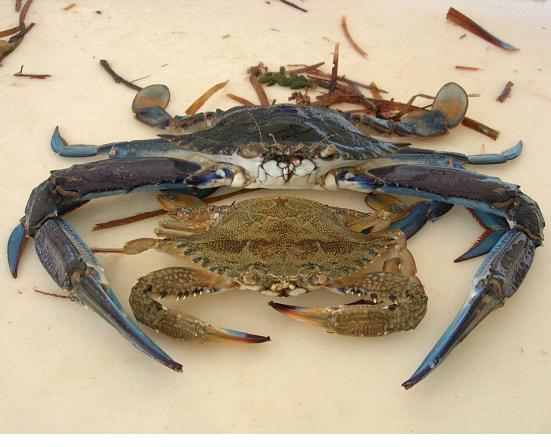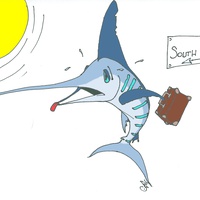Leaving home in a huff: range shifts in Australian seas
Yvette Barry (IMAS).
From barnacles to seaweed and fish, Australian marine life are shifting house in search of cooler waters.
Most fish just want to live a comfy life. Each has a range of conditions, such as water temperatures and pH, in which they prefer to live. So it’s no surprise when studies show some fish are packing up shop and migrating towards the poles – to cooler waters – in response to warming oceans.
What is surprising: there’s still a lot we don’t know about the impacts of climate change on marine ecosystems. Yet Australia’s oceans have been slowly warming since the mid-1900s. For example, the Tasman Sea in southeast Australia is about 2 degrees warmer than it was 60 years ago. (1) That doesn’t sound like much, but for marine life it’s like always leaving the heater on. Even in the summer.
What the available research is showing – along with observations from fishers and divers – is that some marine species are extending their distributions into cooler waters; while others simply disappear from a region when things get too hot at home.
One such study showed 55% of invertebrates surveyed on Tasmania’s east coast – a known ‘hotspot’ for ocean warming - were found further south in 2007 and 2008 than in a 1950’s study. Barnacles and gastropods showed the greatest range extensions over the 60 or so years, according to the joint University of Tasmania and CSIRO study. The giant rock barnacle, Austromegabalanus nigrescens, is now recorded widely along the Tasmanian east coast, but it was absent in the 1950’s study. (2)
Another study looked at the changes in Australian seaweed communities since the 1940s. Dr Wernberg from the University of Western Australia and his associates found many seaweed species have shifted south along Australia’s east and west coasts. But it’s not just one or two species leaving in huff: in some regions, whole seaweed communities have shifted to cooler climes.
So why care about the movement of few slimy seaweeds? The 2011 seaweed study warns that increasing water temperatures may “force many retreating species beyond the limits of available habitat at the southern margins”. If the oceans warm further, seaweed may keep shifting south until there’s nowhere suitable left to move to. This may lead to extinctions and flow-on effects because seaweeds are a unique habitat for many fish and invertebrates. (3)
Anecdotal evidence from fishers, divers and scientists also points to marine shifts.
It was during a marine ‘heat wave’ in 2011, where ocean temperatures in Western Australia were several degrees higher than usual for a few months, that Dr Gary Jackson from the Department of Fisheries in WA started getting calls from fishers reporting uncommon species along the coastline. Reports included subtropical species like Spanish mackerel, whale sharks, emperor species, and damsel fish species observed further south along the WA coast than they’re usually found. And there were reports of fish dieoffs and coral bleaching.
“It was obvious something was going on,” Dr Jackson says.
He hopes more sightings from fishers and divers will help track any southern shifts along such a large coastline.
“There are a lot of people out there on the water or under water or walking on beaches seeing things which would be of interest to us about how the ocean are changing and what the consequences are going to be for fish and fisheries in WA,” he says.
In New South Wales, Associate Professor Natalie Moltschaniwskyj from the University of Newcastle is keeping an eye out for tropical species that are starting to come down the coast from Queensland.
“Anecdotally we are getting tropical species down in Sydney like damselfish and angelfish in the summer but they die off in the winter,” Prof Moltschaniwskyj says.
If more adult fish make it through a winter, it could mean they’re starting to shift their home turf and could be there to stay.
Already Associate Professor Moltschaniwskyj and her team have compiled a list of about 60 species they want to track through the Redmap project, including butterfly fish, painted crayfish and tropical wrasses.
While fishers may welcome hooking new species, there are other less desirable visitors such as the relatively new arrival of longspine sea urchins (Centrostephanus rodgersii) into Tasmanian waters. Thriving urchin populations tend to overgraze the seabed and leave them barren of life. A 2009 study by Ling and his associates at the University of Tasmania suggested the southern movement of the urchin was related to a strengthening of the East Australian Current (EAC) south and coastal warming in eastern Tasmania. Urchins have already formed barrens along much of Tassie’s east coast and may continue further down the coast if marine warming forecasts are realised. Not good news for Tasmania’s kelp forests and marine biodiversity. (4)
.jpg)
The longspine sea urchin (Centrostephanus rodgersii) is devastating kelp beds along Tasmania’s east coast (Photo: Scott Ling)
And yet, other potential shifts into Tasmania are more welcomed. And tasty too! Fishers and divers have been reporting to Redmap more eastern rock lobster, yellowtail kingfish, striped marlin and King George whiting further south than usual.
But it’s not easy to pinpoint how warming waters impact fish along huge coastlines.
There are very few studies of range shifts in South Australian seas according to Keith Rowling, program leader at the Community Based Fisheries section of PIRSA Fisheries and Aquaculture. That’s because South Australia has unique currents that are complicated by cooler Antarctic waters: so they don’t see the more obvious southerly range shifts like those along the western and eastern seaboards.
“We have a fairly unique coastline in that we have cold water coming from the south-east and the warmer Leeuwin currents coming from the west and there’s generally a solid divide there about where the gulf starts,” Mr Rowling says.
But he is keeping track of blue swimmer crab (Portunus pelagicus) sightings. This crab is traditionally found in the upper gulfs of South Australia, but more and more divers and recreational fishers are seeing this species further south, outside the gulf areas. Yellowfin tuna (Thunnus albacares) is another fish to keep tabs on: it’s rarely caught in this state, so any range shift would be noticeable if it moved into SA with potentially warmer waters from the east or west.

Above: more and more South Australian divers and fishers are reporting sightings of the blue swimmer crab further south, outside the gulf areas (Photo: SARDI Aquatics).
But marine critters aren’t just influenced by water temperature. Things like food, predators, acidification, currents, and fishing activity are also thrown into the mix. Additionally, it’s not uncommon for marine animals to swim far from home (considered ‘vagrants’), but they don’t necessarily set up shop there. The normal distribution of a fish is sometimes hard to establish, or not known at all.
That’s where Redmap Australia comes into play. Over time, and with many sightings, Redmap’s community sightings will help uncover if marine species are really extending their range along Australia’s vast coastline, especially as the marine climate warms; or if they are just random visitors or only moving with seasonal variations.
Each Redmap sighting is like a piece of a puzzle that over time will reveal a picture of which species are on the move in Australian seas.
References:
1. Lixin Wu et. al. Enhanced warming over the global subtropical western boundary currents (2012), Nature Climate Change, Volume: 2, Published online: 29 January 2012 http://www.nature.com/nclimate/journal/v2/n3/full/nclimate1353.html
2. Pitt NR, Poloczanska ES, Hobday AJ (2010) Climate-driven range changes in Tasmanian intertidal fauna. Marine and Freshwater Research 61, 963–970.
3. Wernberg T, Russell BD, Thompson MS, Gurgel FD, Bradshaw CJA, Poloczanksa ES, Connell SD (2011) Seaweed Communities in Retreat from Ocean Warming. Current Biology 21, 1-5. doi:10.1016/j.cub.2011.09.028.
4. Ling SD, Johnson CR, Ridgway K, Hobday AJ, Haddon M (2009) Climate driven range extension of a sea urchin: inferring future trends by analysis of recent population dynamics. Global Change Biology 15, 719 - 731.












